“I have invented a new way of imitating flowers”
(Mary Delany)
I have come across the name Mary Delany twice in my research, usually in the field of botanical art. I thought her art interesting but perhaps not worth commenting on. Then I changed my mind. A new book on her life came into bookstores last year and that is where I stumbled upon The Paper Garden, Mrs. Delany {begins her life’s work} at 72, by Molly Peacock. Her life is simply fascinating. This book is well written and full of interesting tidbits; well worth reading. Along with The Paper Garden and other sources, I will tell you about Mrs. Mary Delany of London and hope that it tempts you to learn more.
Mary Delany made quite a stir within the nobility and the various famous botanists, musicians and artists who were part of her circle in the late 1700’s. At the grand age of 72 Mary Delany began the new form of paper collage creating fine crepe-like floral art pieces all set on a black paper background. The voyage to this new type of creation was conceived and nurtured slowly by a life of riches and poverty, marriages and deaths, and flower gardens that inspired.
Mary Granville was born into a British noble family in 1700, Coulston, Wiltshire, England. Her great, great, great grandfather was a member in the royal court of Elizabeth 1. The Granville’s were loyal to the crown of King George the second and his Queen Caroline (who we know from the Kew Gardens (link) post). Mary was the second child, Bernard her older brother and Bevil and Anne who followed. It was with Anne for whom she held strong affection and was her lifelong confidante.
A child of a noble family meant that Mary was well educated. She learned English, French, history, music, needlework and dancing. It was expected and hoped that Mary would gain a place in the English court as a lady in waiting for Queen Anne. When this failed to happen, the family took the advice of Mary’s uncle Lord Lansdowne and married her to Alexander Pendarves at the age of 18.
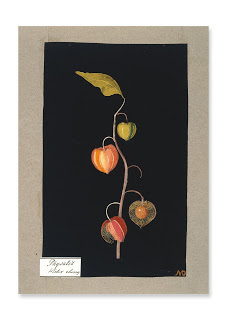 |
| Winter Cherry |
Alexander Pendarves was a man of 60 years and known to drink. He kept a house called Castle Roscrow in Buckland which was close to the sea. This was an unhappy and difficult marriage for Mary. She was a young woman living with an aging alcoholic who was jealous of any male who called. Mary would find some freedom there when Alexander was away on business, as she took to riding along the beach and collecting seashells. During their second year of marriage Alexander’s gout conditioned worsened and they returned to London. She was alone with no friends or family during the first year of the marriage and then his nursemaid for the next 6 years. Upon his death in 1724, it was discovered that Alexander had not provided for his young bride apart from a widows pension. Perhaps it was good fortune that Mary never got pregnant.
For the next twenty years Mary lived with various friends and relatives. She spent much time at the court still hoping for a placement. She remained the single widow but kept herself quite busy with painting and drawing (taught by Louis Goupy) and was friends with many interesting people such as Captain Cook, Handel, Jonathan Swift, painter William Hogarth and botanist Joseph Banks . Mary also met her future husband Dean Patrick Delany, an Irish clergyman, who was engaged to be married at the time. She was very close friends with the Duchess Dowager of Portland (you can find my post on her here). The two women shared a common interest in botany and flowers. It was the Duchess who encouraged Mary to continue with her collages.
How does a noble woman come to create her “flower mosaicks” as she called them? According to Molly Peacock, it was in part due to her collaboration with the Duchess in the creation of the shell grotto at Bulstrode, in part her interest in beautiful court gowns made of fine layers of fabric, but most importantly her marriage to Patrick Delany a garden enthusiast.
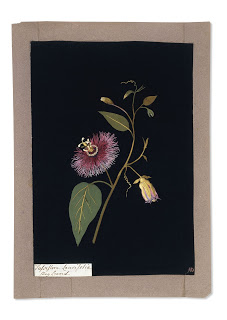 |
| Passion Flower |
The Delany’s were married in June 1743 and divided their time between England and Ireland where Patrick had his congregation. Patrick already owned a home in Ireland called Delville and was very involved with the gardens and the property. Theirs was no small house in town. Delville was very large even by today’s standards (but not for one of noble birth). A circular road ran around the house and was wide enough for a coach and six horses. The property’s plantings followed the contours of the land, and included “a bowling green, a high bank, a circular terrace, flowers walks, and fruit trees”. There was a kitchen garden and two fruit gardens near the house, and beyond were fields “planted in a wild way”. Mary was no stranger to gardens and is known to have enjoyed those at Bulstrode with the Duchess, as well as gardens of other acquaintances. At Delville Mary had built an orangery and a grotto. The Delany’s spent much time in their gardens and the love of gardens solidified a happy marriage of 25 years. Patrick’s
“encouragement of her gardening, painting, shell-work and needlework resulted in a surge of activity in a variety of media in all of which the basic theme was the flower, whether in stocking the Delville garden, painting garden landscapes, decorating interiors with shells, or working embroideries.”
After a long illness, Patrick Delany died at 84. Mary was 67 years.
Mary was forced to sell the properties and their coach to pay debts to lawyers for a law suit that had plagued the Delany’s years ago. Without sufficient funds to live on her own, again, she was fortunate in her friendship with the Duchess of Portand who gave her a room at Bulstrode. It was here, at the age of 72, that Mary began cutting pieces of paper with a knife, arranging, layering and gluing them on a black paper background. Her flower mosaicks became a project called the hortus siccus (dry garden) and then later renamed the Flora Delanicus. The Duchess of Portland was the one that encouraged Mary in her work and supported her talents by spreading the word around her circle of friends.
Through the Duchess Mary met two prominent botanists Joseph Banks and Daniel Solander, who in their way encouraged her fascination in the details of plant structure. Even King George the 3rd heard and viewed Mary Delany’s mosaicks.
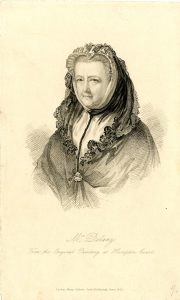
Eventually Mary was unable to continue her flower collages due to failing eyesight. She had hoped to create a round number of 1000 and nearly achieved it, needing to stop at number 985. Today her flowers can be seen at the British Museum. They also house most if not all of the surviving letters, including her correspondence with Anne.
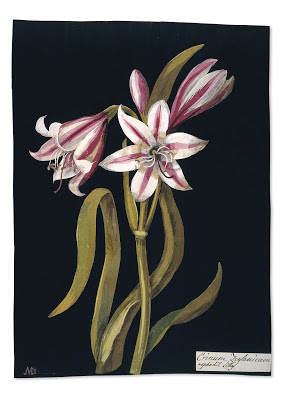 |
| Asphodil Lily Crinum zeylanicum |
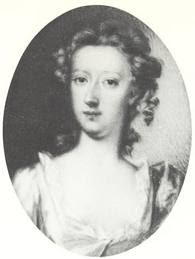
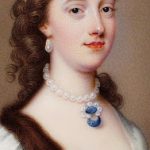

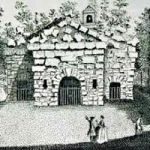
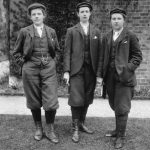


Thank you Aileen (?) for the very kind words. I know I don't have a large readership and so when someone takes the time to read one of my posts it helps in my pursuit and desire to honour women lost to history.
I always look forward to your well written and researched posts.This one is fascinating.I would love to see this art work "in person".
It's amazing that these are collages!! They look like they've been painted. I agree with Carolyn – I'd love to see these in person! Ya gotta love a woman who starts over at 72! :o)
Thank you both for your comments. The art is certainly part of the reason I decided to look into Mrs. Delany more, her work now has a place in art history. Then, once I started reading the book mentioned I was addicted to her story.
I just read a review of this book in the Washington Post the other day and immediately thought of your blog!! I'm going to add it to my summer reading list. If I hadn't read your blog, I might have skipped the article. Hooray for you!!! :o)
I just read about Mrs. Delany for the first time in a magazine/newspaper.She is an inspiration for those like me who still haven't found the dream after all these years.
Thanks for this blog!
I randomly found your blog yesterday and am having the BEST time reading all these biographies. I’m a stay-at-home mom with a busy little boy, and reading for any length of time is nearly impossible. You’ve provided readings I can do in one sitting – a huge blessing! Thank you so, so much.